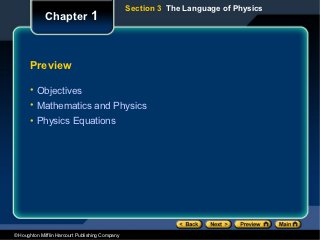Weitere ähnliche Inhalte
Mehr von Keller Williams Lynchburg (13)
Kürzlich hochgeladen (20)
Chapter 1 lesson 3 Powerpoint
- 1. Section 3 The Language of Physics
Chapter 1
Preview
• Objectives
• Mathematics and Physics
• Physics Equations
© Houghton Mifflin Harcourt Publishing Company
- 2. Section 3 The Language of Physics
Chapter 1
Objectives
• Interpret data in tables and graphs, and recognize
equations that summarize data.
• Distinguish between conventions for abbreviating
units and quantities.
• Use dimensional analysis to check the validity of
equations.
• Perform order-of-magnitude calculations.
© Houghton Mifflin Harcourt Publishing Company
- 3. Section 3 The Language of Physics
Chapter 1
Mathematics and Physics
• Tables, graphs, and equations can make data
easier to understand.
• For example, consider an experiment to test Galileo’s
hypothesis that all objects fall at the same rate in the
absence of air resistance.
– In this experiment, a table-tennis ball and a golf ball are dropped in a
vacuum.
– The results are recorded as a set of numbers corresponding to the
times of the fall and the distance each ball falls.
– A convenient way to organize the data is to form a table, as shown
on the next slide.
© Houghton Mifflin Harcourt Publishing Company
- 4. Section 3 The Language of Physics
Chapter 1
Data from Dropped-Ball Experiment
A clear trend can be seen in the data. The more time that
passes after each ball is dropped, the farther the ball falls.
© Houghton Mifflin Harcourt Publishing Company
- 5. Section 3 The Language of Physics
Chapter 1
Graph from Dropped-Ball Experiment
One method for analyzing the data is to construct a graph of
the distance the balls have fallen versus the elapsed time
since they were released. a
The shape of the
graph provides
information about
the relationship
between time and
distance.
© Houghton Mifflin Harcourt Publishing Company
- 6. Section 3 The Language of Physics
Chapter 1
Physics Equations
• Physicists use equations to describe measured or
predicted relationships between physical quantities.
• Variables and other specific quantities are abbreviated
with letters that are boldfaced or italicized.
• Units are abbreviated with regular letters, sometimes
called roman letters.
• Two tools for evaluating physics equations are
dimensional analysis and order-of-magnitude
estimates.
© Houghton Mifflin Harcourt Publishing Company
- 7. Section 3 The Language of Physics
Chapter 1
Equation from Dropped-Ball Experiment
• We can use the following equation to describe the relationship between
the variables in the dropped-ball experiment:
(change in position in meters) = 4.9 × (time in seconds)2
• With symbols, the word equation above can be written as follows:
∆y = 4.9(∆t)2
• The Greek letter ∆ (delta) means “change in.” The abbreviation ∆y
indicates the vertical change in a ball’s position from its starting point,
and ∆t indicates the time elapsed.
• This equation allows you to reproduce the graph and make predictions
about the change in position for any time.
© Houghton Mifflin Harcourt Publishing Company

